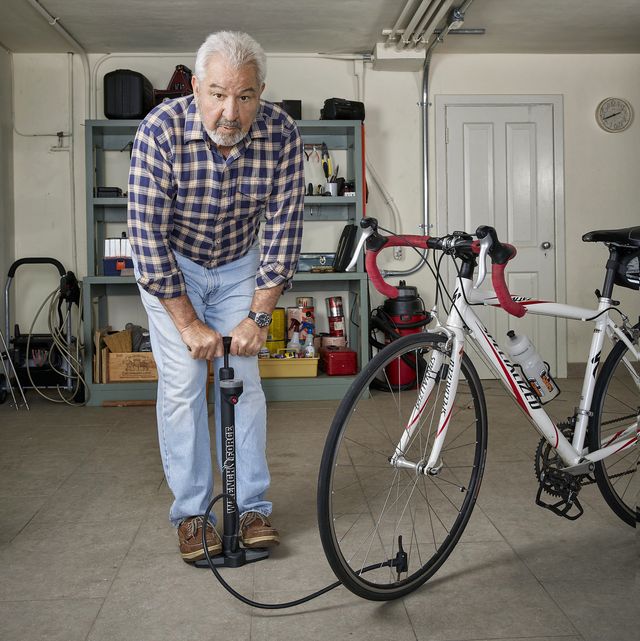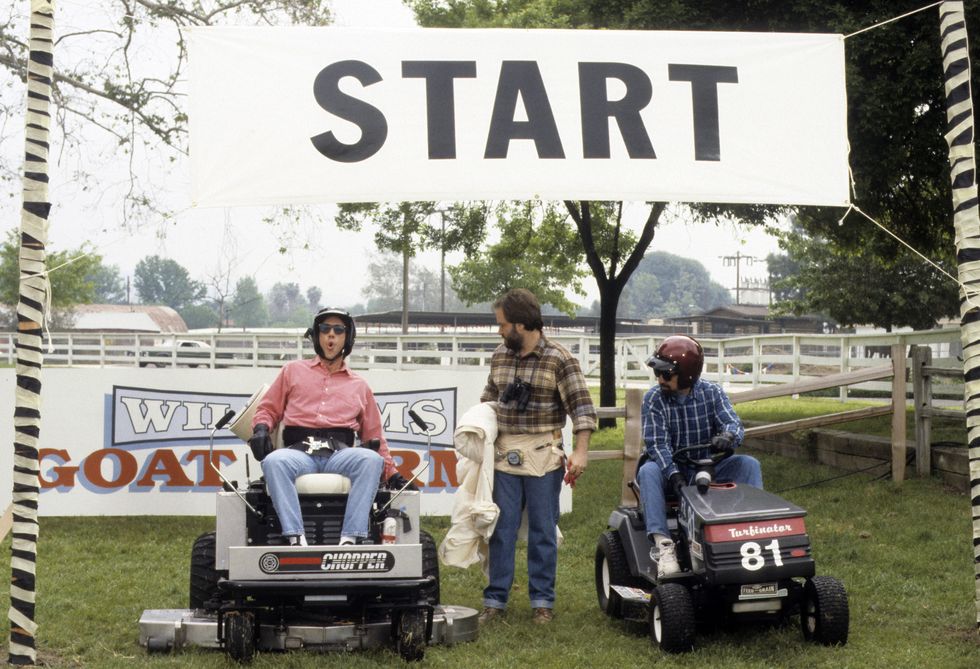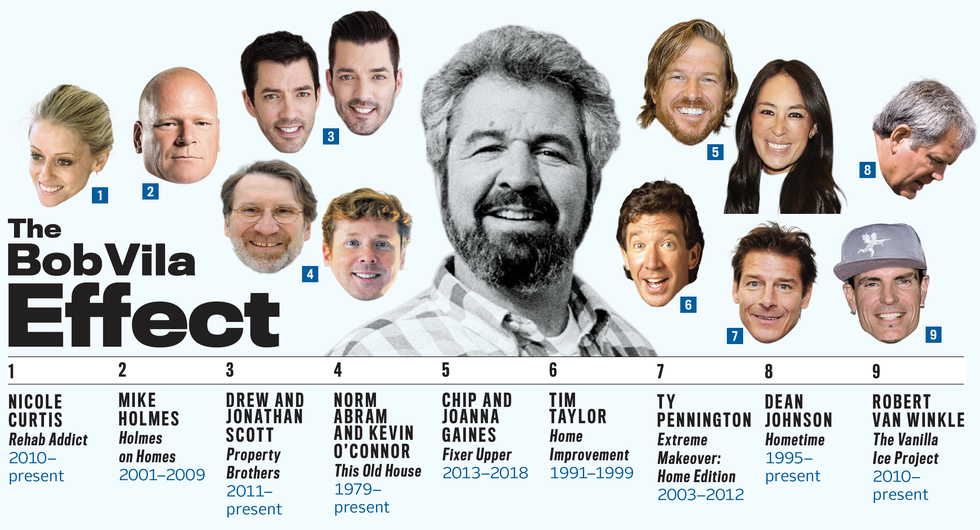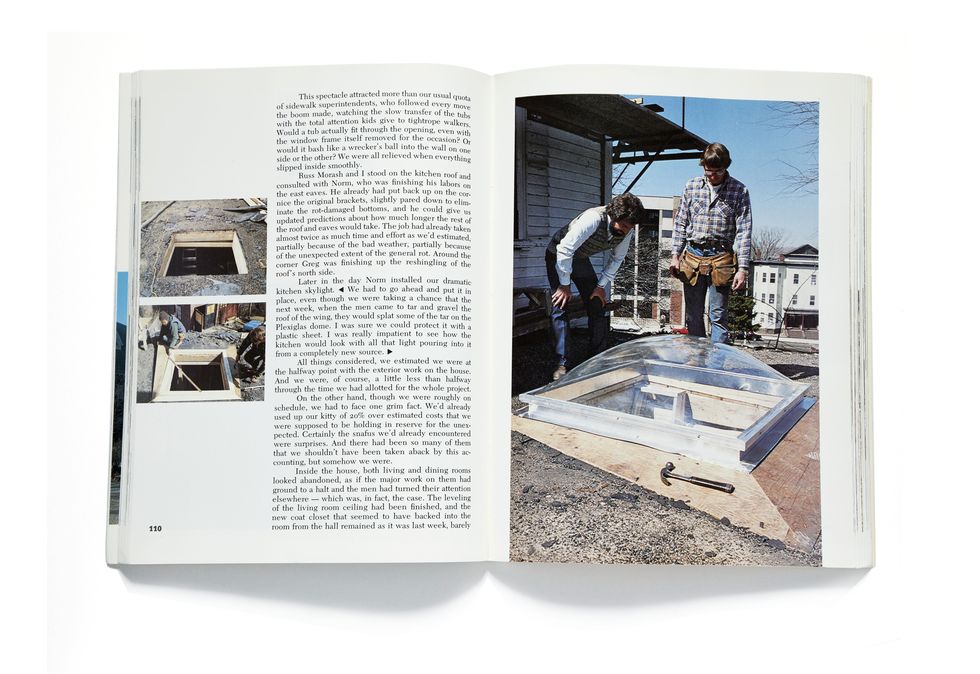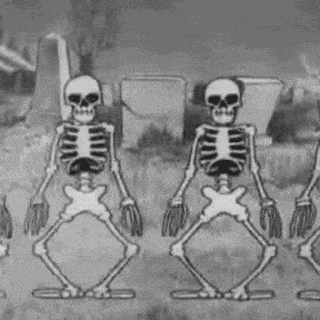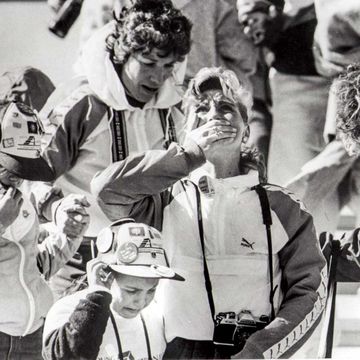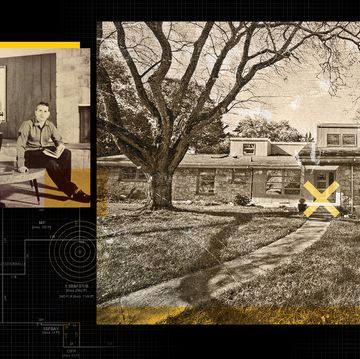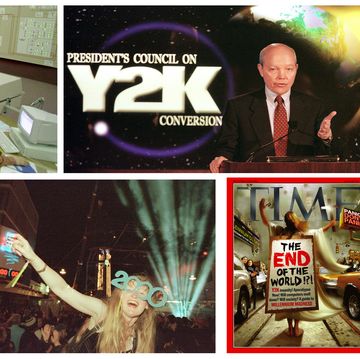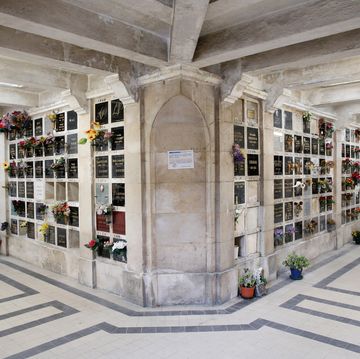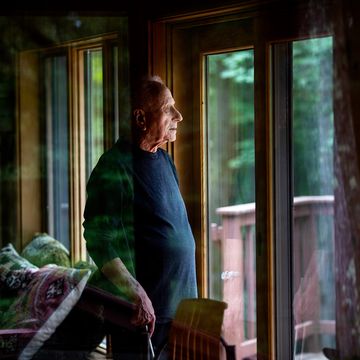You recognize the plaid shirts, the soothing voice. The constant calm and encouragement. Bob Vila taught and entertained homeowners for decades. But what is the first true reality-TV star up to now? Building the future of Bob Vila.
When Bob Vila moves uptown—through the rain and morning foot traffic, into the cold November breeze—he does not stop talking. This is Manhattan, at 10:40 in the morning. The sidewalks on the Upper East Side, near Vila’s home, are jammed with Christmas shoppers. Vila’s voice carries into a morning tumult of cellphones and overcoats, shopping bags and umbrellas. He’s discussing the problem of restoring Ernest Hemingway’s house outside Havana, which now stands as the Hemingway Museum at Finca Vigía. He’s been serving as a consultant on the project for over a decade.
And he is nothing if not a narrator. Because it’s Vila—or perhaps because of Vila—it’s a story we are familiar with, told in the particular fits and starts of the teardown, assembly, and construction of an old house. “The roofing tiles are a good example. The pallets of tile that arrived on the building site were too brittle. They couldn’t even be installed. Their manufacture was trapped in an entirely outdated process.” Vila turns his shoulder and ducks past a pair of window shoppers. “Cuba, of course, was still using seventy-five-year-old technologies in the manufacture of building materials.”
At the corner, Vila hustles forward to cross traffic with the light, speaking over his shoulder. “This created a lot of problems in the climate control and HVAC, the museum end of things, where they had letters and manuscripts that demand pretty strict climate control in their storage.”
An icy wind blows through the cross streets. Vila presses forward. At the first corner, and again at the next one, just every once in a while, someone turns for a look at the guy, toward his familiar voice. Bob Vila, narrating a construction problem. It must be like sighting a rare bird. Natural enough. But what else would he be doing? In this case, he delivers the solution for the roofing tiles two blocks farther uptown. “In the end, we found some really terrific tiles manufactured in Ohio of all places,” he says. He extends his arm expertly. And, miraculously, a taxi seems to appear out of the chaos. He’s headed far uptown to the Hispanic Society Museum & Library for a consultation on a massive roof-replacement project. “It’s fascinating,” he says, “to think of how far building technology has come since Cuba closed itself off. I was just starting college then. All my life really.” He says he’ll wait out front to meet. “It was built with a 19th-century design, so there are lots of puzzles. We’ll go right onto the roof and get a closer look at the work they’re doing to bring in the light of a new century.”
Honest to God. Just like that, Bob Vila gives a reasonable teaser for the work he’ll be looking at this afternoon. The man was made for television. His work is always at hand.
Who is Bob Vila anyway? The first reality-television host? A contractor who got lucky? A longtime paid spokesperson for Craftsman tools? The storyteller of a generation? The guy from Hot Shots! Part Deux? A journalist carpetbagging as a contractor? Or beloved, comfy-cozy television host, who wore his own clothes to work? Or perhaps merely the first-ever personality to consciously brand himself and move on from his first success?
Simply put, Vila’s job was that of a new kind of storyteller. On This Old House, the iconic home-renovation program he hosted from 1979 to 1989 that continues today on PBS and has won seventeen Emmys, he had a unique role: to describe, to kneel and peer into a crawl space with a flashlight, to pull at the decaying lath, to illustrate the dangers of moving forward with the work. To translate detail and describe the difficulties contractors, and homeowners, sometimes faced. Throughout This Old House, Vila leaned in on the personality, capability, and vision of the tradesmen and contractors who came to each worksite. Bob Vila’s interview subjects were always real, sometimes odd; Vila was always Bob. He shared the camera with them wisely. They were often older, somehow wizened, had regional accents, and offered up hard-won, homespun lessons. This was the furthest reach of reality television back then, and Vila was well suited to it.
Vila was a young guy, with the faint whiff of a former hippie, who’d worked in home construction (after returning from similar work in the Peace Corps in Central America). Keep in mind that in 1979 network-television terms, escapist fun like Dynasty was only a couple years away and Diff’rent Strokes was about as gritty as television got. And suddenly, over on PBS, the fourth channel in most viewing areas, here was This Old House making the possibility of sweating copper lines to the new bathroom into something you hoped for as a cool plot point. And it worked.
Calm. Steady. Engaged. Vila brought the curiosity of a newspaperman (he graduated from the University of Florida with a degree in journalism) and extensive experience with renovation and contractors (in 1978, he was selected to audition for This Old House after winning an award from Better Homes and Gardens for his renovation and restoration of a Victorian Italianate house in Newton, Massachusetts), and knew how to talk to working folk without anybody looking like a rube. Every now and then, Vila would grab a wire brush or a pry bar and go to work.
Then, as now, you watched This Old House to learn. And it was natural to zero in on Bob Vila because you sensed that he cared about the outcome of the projects from week to week, from season to season.
He’s seventy-two now, head of a laundry list of endeavors designed to make money. He’s still dapper, still favors the plaid shirt and the khaki pants, even the down vest, when out and about. He’s sitting at breakfast today, mulling over the implications of letting a key employee go from his online empire. It seems to pain him. He claims he’s begun the work of streamlining some of his obligations, but it sounds hectic. “BobVila.com is the only media presence I still have that I still manage. I just took over as CEO again, because I want to be more involved. I need to update the publishing end. Toward the internet. That’s the way publishing is going. I never thought of becoming a web publisher, but now suddenly I’m a web publisher.”
He can go on about that business. He does. “We have the old shows in a video library on BobVila.com, and we’re still producing video content that we’re adding through social media,” he says. It’s raining outside, and getting colder. Vila’s got to be thinking of getting south, where he lives part of the year in Palm Beach, nearer his son’s family. It’s warmer too. He’s asked: Does he dress like Bob Vila in South Florida? He doesn’t seem to know what that means, before he’s cued. The whole down-vest thing? The flannel shirts? He laughs at the thought. “Not so much,” he says. “But I was born in Miami, so I know how to dress down there.”
The lasting association between Vila and the American audience (the show had eleven million weekly viewers at its height under Vila) is that first one—that guy and his look—Vila in the plaid shirt, moving from job to job in an old house, working to focus his audience on the particulars of the work being done there. The show grew so popular that it inspired a generation of television hosts-to-be. Jonathan Scott, one half of HGTV’s hit show Property Brothers, gives quick and easy credit to Vila for piquing his interests—performing, contracting, building. “He was always on our television, always in the background of everything we did,” he says. “He was enthusiastic and interested. He asked good questions, he was always looking into things. He was like us—like a student, mostly. That guy was like the soundtrack of our lives, the voice coming from our TV room. I’d recognize his voice anywhere.”
Vila left the show thirty years ago, after a vague controversy surrounding his commercial endorsement of a New Jersey hardware outfit, but somehow he is still most closely associated with his time as the renovation tour guide for the first home-improvement show ever. Men and women of a certain age remember Vila, working a construction problem with master carpenter Norm Abram in the gutted living room of some crumbling gem in suburban Boston. Abram proved to be a television force of his own, but the back and forth between them was remarkably subtle and unscripted ball-busting. It is remembered still. “That’s a generational thing,” Vila says. “We were the first to do it. We got bolder, and did more every season, sure, but the show stayed on point. The producers always said it was simple: demystify what’s behind the plaster. That same story was right there in people’s homes, too.”
Vila is prompt to give This Old House the lion’s share of the credit for his success. His recognition as a cultural icon, however, is really his own work. The branding thing is no joke with the man. In 1990, Vila broke away from PBS and started his own show, Home Again with Bob Vila, which lasted sixteen years on cable. (It was eventually retitled simply Bob Vila, which by then said it all.) He followed that by setting up his own website, accompanied that by writing twelve books on architectural history, renovation, restoration, and do-it-yourselfing. In 2016, he released a retail line of tools named Bob Vila.
What may have cemented Vila into the foundation of the current cultural consciousness of America may have come in the ’90s, when comedian Tim Allen starred in a sitcom with the name Home Improvement, based in part on the chemistry between the host (Allen’s character, Tim Taylor) of the fictional improvement series Tool Time and his affable, skeptical expert tradesman (Al Borland, played by Richard Karn), who played a version of Norm Abram. To complicate the doppelgänger situation entirely, Vila himself had an occasional role on the show, playing himself, as a more competent and expert rival host to Taylor’s version of, erm, Vila himself.
In creating the show, Allen was not shy about borrowing on what worked between Vila and Abram. “I loved the implied relationship between Bob and Norm, the everyday quality of things. They seemed to be kidding each other sometimes. And I ran with that at the beginning,” Allen says. “But in comedy, you’re always looking for any little thread of tension between contractors. I was imagining theirs mostly. I used my own stand-up material with construction work, and I threw a guy like Bob into it, thinking what if he had to fake that kind of authority. Exaggerating things is kind of a tool for a comedian.” Does America owe the creation of Tim Taylor to the emergence of Bob Vila? Allen pauses for a second. “Without the show This Old House, there would be no Home Improvement,” he says. “But Tim Taylor isn’t Bob. Bob is a nice guy, a terrific guy, and he knows a lot more than Tim Taylor ever did.”
Vila is sometimes portrayed as a guy who deserted This Old House ten years after its creation to pursue a career in self-promotion. The story feels pretty precious when considered against the standards of today’s social-media and self-promotion industry. To the parochial PBS viewer at the time, it was an unprecedented, somewhat unforgivable act of ego to desert the home franchise, whereas today we might call it a simple rebranding.
Some resentment remains. Sources at This Old House, still on the air after four decades, are reluctant to talk about Vila, though it may be that most can’t remember him. Three decades have passed. The show endures. Vila himself is often still roasted on internet discussion boards for being a man playing a part, pretending to be a contractor. For his part, Vila seems genuinely grateful to producer Russell Morash and the PBS experiment, forty years later. “Russ always said we were just trying to take the mystery out from what’s behind the walls, taking apart the layers and discovering the problems. Then it was talking to people. When you have a background in journalism, you know what the questions are and you know how to get the answers and how to make them simple and clear. So that all worked out,” he says. He sighs. “I mean, I did bring something to the equation. It was serendipitous, really. I was a guy who’d studied architecture. I was passionate about it, I’d lived in Europe and in Latin America, but I also had a degree in journalism. Why wouldn’t I end up doing a broadcast show about building?”
And why wouldn’t he move on? Vila started on This Old House making $200 a week. Appropriately modest for the show that started out as an experiment on the part of Morash (who had previously created Julia Child’s show and The Victory Garden) at the PBS affiliate in Boston. After a decade at the center of This Old House, Vila was making $1,200 a week.
When he began making commercial endorsements (over the protests of his producers), existing program sponsors, like emergent Home Depot and Weyerhauser, started to pull their funding from the show’s coffers, and Vila was forced out. Viewers were angry with the change at the time. Vila was sometimes cast as the greedy diva, who’d tried to use his personality to get money. In the rationale of the moment, it was like imagining if Olympic athletes were paid. We see where that’s gotten us, like it or not. It may have in fact been the last days of premium amateurism, a time when people were expected to substitute the cursory pleasures of fame for the possibilities of monetizing anything from them.
If there is Vila resentment that survives at This Old House, it’s pretty camouflaged by the wall of Emmys they’ve won in the time since then. “Bob was a terrific talent, and continues to be a name frequently associated with our show by viewers of the brand even though he left the show in 1989,” says Eric Thorkilsen, CEO of This Old House Ventures. “Happily, with the introduction of Steve Thomas in 1989, and Kevin O’Connor in 2003, This Old House now has the largest audience in its forty-year history.”
Vila, who’s called himself a capitalist at heart, makes no bones that he wanted more from the show. “It was a great place for me to start. Probably the place. But that was the ’70s and the ’80s. I was young. I worked hard. I got lucky, I got some help, and I used what I had,” he says, hands out, flannel sleeves folded up to his elbows. “In this business you learn the camera’s your friend or it’s not.”
For his part, Vila says, there is no bad blood. “I’m grateful,” he says. “But I never talk to those guys.”
Did Vila take some secret away from the format of This Old House to make his mark in the years that followed? While he believes he’s developed since then, he knows there was some luck. “Having produced the Home Again shows for so many years, having hosted This Old House for ten, and interviewing so many regular people, you start to recognize the ones who are going to be good interviews and the ones that are going to be difficult. You deal with it.”
People are quick to give Vila credit for being the first reality-TV show host, just as they often cite This Old House as the first true reality show. Vila doesn’t much want that credit; at least, he merely shrugs upon hearing it. “Back then, we came out of the background of educational TV. That was the work of it. Teaching.” He smirks a little at the thought of today’s construction shows. “The programming today comes from the tradition of Queen for a Day. You know, they take this family that’s living in a squalid situation, send them on a cruise, and when the family comes back, bingo, they’ve got a palace.” Here Eric Thorkilsen concurs with Vila: “This Old House has always devoted as many as twenty-six episodes to cover a single project, providing far greater information on the process and techniques involved.”
Put the question to Vila, and he’ll tell you he was never a general contractor. He was never trying to convince anyone of that. “I did the hiring on my projects,” he says. And he was never a tradesman. “I did the work I could at the start, like any young guy. But I learned to listen to the guys who worked for me on my projects.” He took some of that trust into the creation of the show.
“Mostly, I was the developer on Home Again, that’s what I knew how to do. It’s what I’d done on my own restorations. I was the guy who put together the money deal, put together the purchase, put together the contractors, pulled in the architect. I brought people together.”
“Bob was a teacher,” Tim Allen says. “He still is. When I remodeled my house in Michigan, I wanted to have him in for a look at what I was building. I just wanted to impress him, you know? Like a favorite teacher from high school. I mean, he’s Bob Vila, right? And he signed his name in some wet concrete in the garage somewhere. I just wanted his name on my house, somewhere. You know, a ‘Bob Vila was here’ kind of thing. The guy really was everywhere then.”
Under the dome of a large construction tent on the roof of the Hispanic museum, a welder and framing carpenter listen to the voice pouring from the platform above them. The sonorous narration echoes downward, weirdly familiar to them both. Voice: en-gaged and certain, coaxing somehow. They tilt their heads and squint, each of them working to place the speaker, who’s describing, or explaining the work being done here, which in-cludes the removal and replacement of the building’s original flat roof, which is a century old now, which has leaked for years, into the attic space, the gallery space.
The voice: inquisitive and curious, but oddly authoritative. This is their job, but he gets it. “There was originally a skylight here. And at some point, it was just covered from above and forgotten. So they’re working to figure out, at least in this next phase of the renovation, whether to replace it with something more akin to solar tubes, which are a great product for allowing natural light into a space.”
The two men busy themselves but stay in earshot. They want to see this guy, whoever it is. The welder coils a hose. The carpenter gathers spilled carriage bolts in his gloved hand. They listen, and cipher their past, the practice in the way he speaks, the eagerness for detail.
It’ll come to them.
“And now they have to figure out how to deal with damage to the interior ceiling, which is a challenge when they haven’t been able to see what’s in this attic, behind this plaster and lath, for over one hundred years.”
The speaker is not wrong about the job. The guy knows some things. What is he? A contractor? A professor? An architect?
And when this speaker steps onto the platform above them into view, the welder exclaims: “It’s him!”
A little guy, compact in his vest, locked in on the story of this place. The welder grasps for a name. It’s been a while since he’s seen this guy, the speaker, who boot-clunks down the ladder. Decades maybe.
Meanwhile the carpenter watches him descend, takes in the khakis, the flannel shirt, the down vest. Suddenly, it adds up for him. “I knew it,” he says, “that’s him.”
The welder looks at his friend like he’s crazy. “What’s the name?”
The carpenter nods toward the man working his way down the rungs. Bob Vila. But the names escapes them.
“I think he’s been here before,” the carpenter says.
Bob Vila waves to them from the ladder. They wave back, then close in for a handshake. They want to hear what Bob Vila has to say about the work at hand.
This appears in the May 2019 issue. Want more Popular Mechanics? Get Instant Access!
